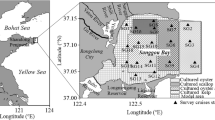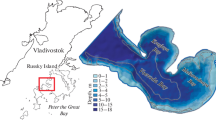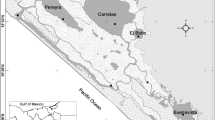Abstract
A one-dimensional ecosystem box model is presented forcarrying capacity assessment. The model includesphysical and biological processes. The physicalprocesses are the transport of nutrients, suspendedmatter and phytoplankton through the system boundariesand between model boxes. The biological processes areprimary production and oyster (Crassostreagigas) population dynamics and physiology. The modelwas implemented using an object-oriented approach. Themodel was employed to estimate the carrying capacityof Carlingford Lough (Ireland) for oyster culture. Inthe Lough, low water temperatures prevent the oystersfrom reproducing. Therefore, recruitment ishuman-dependent. Small oyster spat is seeded everyyear during spring and harvested after the summer ofthe next year. During this period oysters reachcommercially harvestable weight. The results obtainedindicate that the carrying capacity of this system isapproximately 0.45 g oysters (AFDW) m-3,determined more by the availability of particulatematter than by phytoplankton. It is suggested that afive-fold increase in oyster seeding may optimiseharvest yield.
Similar content being viewed by others
References
Bacher C (1989) Capacité trophique du bassin de Marennes-Oléron: couplage d'un modèle de transport particulaire et d'un modéle de croissance de l'huître Crassostrea gigas. Aquat Living Resour 2: 199–214
Bacher C, Héral M, Deslous-Paoli and Razet D (1991) Modèle énergétique uniboite de la croissance des huîtres (Crassostrea gigas) dans le bassin de Marennes-Oléron. Can J Fish Aquat Sci 48: 391–404
Ball B, Ferreira JG and Keegan B (1994) Development of a model to determine the trophic capacity of mollusc rearing areas in Ireland and Greece. Final Report to the CEC for project FAR-AQ2516
Baretta J and Ruardij P (eds) (1988) Tidal flat estuaries. Simulation and analysis of the Ems Estuary. Springer-Verlag, Berlin
Bayne BL (1993) Feeding physiology of bivalves: Time dependence and compensation for changes in food availability. In: RF Dame (ed.). Bivalve filter feeders in estuarine and coastal ecossystem processes. (pp. 1–24) Springer-Verlag, Berlin
Bernard FR (1974) Annual biodeposition and gross energy budget of mature pacific oysters, Crassostrea gigas. J. Fish Res Bd Can. 31: 185–190
Brock TD (1981) Calculating solar radiation for ecological studies. Ecol Modelling 14: 1–9
Carver CEA and Mallet AL (1990) Estimating carrying capacity of a coastal inlet for mussel culture. Aquaculture 88: 39–53
Douglas DJ (1992) Environment and Mariculture (A study of Carlingford Lough). Ryland Research Ltd., Ireland
Ferreira JG (1995) EcoWin — An Object-oriented Ecological Model for Aquatic Ecosystems. Ecol. Modelling 79: 21–34
Grillot N and Ferreira JG (1996). Ecological model of the Cala do Norte of the Tagus Estuary. ECOTEJO, Rel. A-8403-06-96-UNL, Ed. DCEA/FCT, New University of Lisbon
Heral M (1993) Why carrying capacity models are useful tools for management of bivalve molluscs culture. In: R.F. Dame (ed.). Bivalve filter feeders in estuarine and coastal ecossystem processes. (pp. 455–477) Springer-Verlag, Berlin
Ittekot V, Brockmann U, Michaelis W and Degens ET (1981) Dissolved, free and combined carbon hydrates during a phytoplankton bloom in the Northern North Sea. Mar Ecol Progr Ser 4: 259–305
Jørgensen SE, Nielsen S and Jørgensen L (1991) Handbook of Ecological Parameters and Ecotoxicology. Elsevier, Amsterdam
Portela LI and Neves R (1994) Modelling temperature distribution in the shallow Tejo estuary. In: Tsakiris & Santos (ed). Advances in Water Resources Technology and Management. (pp. 457–463) Balkema, Rotterdam
Press WH, Teukolsky SA, Vetterling WT and Flannery BP (1995) Numerical recipes in C — The art of scientific computing. Cambridge University Press, Cambridge
Raillard O (1991) Etude des interactions entre les processus physiques et biologiques intervenant dans la production de l'huitre japonaise Crassostrea gigas du bassin de Marennes-Oléron: essais de modélisation. Thèse doct. Océanographie, Univ. Paris VI
Raillard O and Ménesguen A (1994) An ecosystem box model for estimating the carrying capacity of a macrotidal shellfish system. Mar Ecol Prog Ser 115: 117–130
Schildt H (1995) C++, the complete reference, 2nd. Edition. Osborne
Sekine M, Nakanishi H, Ukita M and Murakami S (1991) A shallow-sea ecological model using an object-oriented programming language. Ecol Modelling 57: 221–236
Silvert W (1993) Object-oriented ecosystem modelling. Ecol Modelling 68: 91–118
Sinko JW and Streifer W (1967) A new model for age-size structure of a population. Ecology 48: 910–918
Sinko JW and Streifer W (1969). Applying models incorporating age-size structure of a population to Daphnia. Ecology 50: 608–615
Steele JH (1962) Environmental control of photosynthesis in the sea. Limnol Oceanogr 7: 137–150
Streifer W (1974) Realistic models in population biology. Adv Ecol Res 8: 199–266
Stumm W and Morgan J. (1981) Aquatic Chemistry, 2nd. Edition. Wiley-Interscience
Usher MB (1966) A matrix approach to the management of renewable resources, with special reference to selection forests. J Appl Ecol 3: 355–367
Valiela I (1995) Marine ecological processes, 2nd Edition. Springer-Verlag
Vicente P (1994) DifWin: A package for the definition of compartments and calculation of dispersion coefficients in box models — Application to the Carlingford Lough. In: Proceedings of the First International Conference on Hydroinformatics, Delft, The Netherlands, 717–721
Willows RI (1992). Optimal digestive investment: A model for filter-feeders experiencing variable diets. Limnol Oceanogr 37: 829–847
Author information
Authors and Affiliations
Rights and permissions
About this article
Cite this article
Ferreira, J., Duarte, P. & Ball, B. Trophic capacity of Carlingford Lough for oyster culture – analysis by ecological modelling. Aquatic Ecology 31, 361–378 (1997). https://doi.org/10.1023/A:1009952729216
Issue Date:
DOI: https://doi.org/10.1023/A:1009952729216




